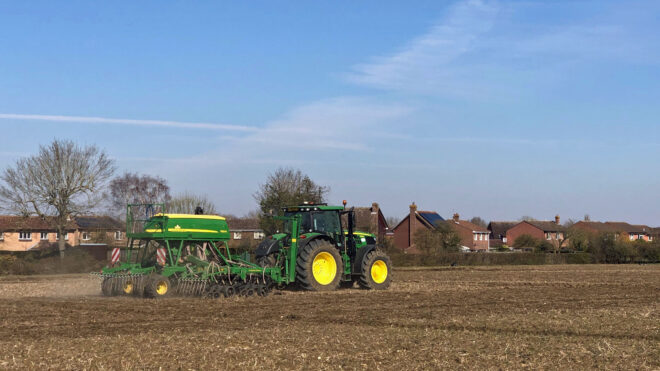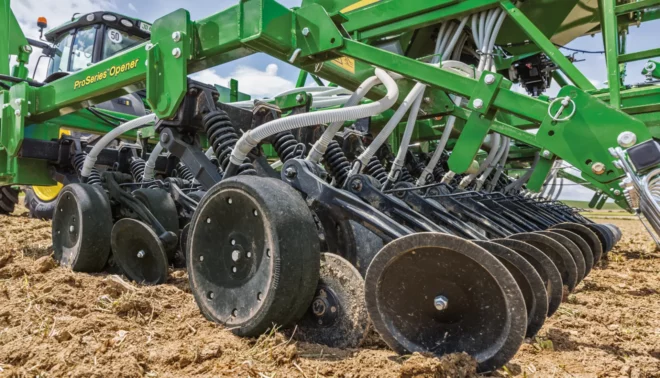Whether its beans or rape, on clay or sand, across open hectares or in trial plots, the accurate and versatile John Deere 750A drill has won many fans. David Purdy puts its popularity down to a number of factors.
Chief among those is the accuracy of seed placement across a wide range of soil-types and conditions. One of the reasons for that is that the depth control wheel is positioned next to the coulter rather than behind or in front of it on other drills, explains David.
The seed, then, can be placed precisely at the set depth and is less influenced by stones or clods as in systems where the wheel is mounted before or after the coulter. The opener disc; canted at seven degrees, and the press wheel provide good slot closure and the vital seed-to-soil contact needed for uniform emergence.
Recently the drill has seen a renaissance in sales as growers moved into min- and no-till systems, says David. “It’s nimbler than heftier alternatives so compaction is reduced, suiting it well to low-disturbance set-ups,” he explains.
The 750A can, therefore, operate over an extended season, getting on to land earlier in the spring and later into the autumn, adding to its versatility. A further advantage of its scale is in potential fuel savings. The six-metre version of the 750A can easily be pulled by a 150hp tractor unit which means fuel costs are kept to a minimum. “Added to that, it’s simple to maintain and reliable, virtually bomb-proof in fact, which cuts out downtime at crucial stages in the season,” David says.
These factors are all key to producers who already own a 750A. Here, some of those give their views on what it’s like to live with it.
David Walston, Thriplow Farm
Arable:
900 ha
Crops:
Winter wheat, winter barley,
winter beans, spring oats,
sugar beet and sometimes oilseed rape.

Soil:
medium-light
to medium-heavy,
chalky
Rainfall:
550 mm a year
The farm also has grassland for horses and woodland areas. Significant areas are under a Countryside Stewardship Scheme higher tier agreement and the farm has taken part in the pilot Sustainable Farming Initiative.
David and the team at Thriplow went fully no-till in 2016 and have been using multispecies cover crops including vetch, linseed, buckwheat and phacelia since 2011. David wanted a disc drill to be able to drill into cover crop residues. To find out which drill worked best, he carried out a trial of the 750A, along with two others, before making a purchase.

While on heavier land there was only a 50kg/ha yield difference across the three machines, on lighter land wheat sown with the John Deere 750A produced 0.8t/ha (8%) more grain.
That was a result of a higher plant establishment, with 50-80 more plants/sq m than the other two drills on lighter land, and 120-130/sq m on heavier soil.
The 750A was chosen and seven years on, it is still the mainstay of the drilling operation at Thriplow Farm. “We use it to drill about 75% to 80% of the crops including winter wheat, beans, spring oats and spring barley,” David says. “It copes easily with 500ha of winter crops in the autumn, it’s robust and we get good establishment when drilling into crop residue.”
Although only a relatively small amount of drilling is into taller cover crops, yields have been better than the wider settings on the farm’s other drill.
James Goodley, Goodley Farm Services
Arable:
800 ha
Crops:
Winter wheat, spring barley,
oilseed rape and both vining
and combinable peas with
Countryside Stewardship Scheme option AB15:
Two-year sown legume fallow

Soil:
Largely,
sandy loam
Rainfall:
724 mm a year
James bought a six-metre 750A about six years ago with part-funding from a Leader grant during the farm’s transition from a plough-based setup, through min-till to a no-till system.
In a careful selection process, James tried a number of other no-till drills on the market.
“The reason we chose the 750A was because every other drill we tried required relatively high horsepower,” he says. “And, because of the weight of the drills on a heavily cultivated or ploughed field, the others quickly buried themselves, while the 750A didn’t.”
While getting the soils right for no-till, the farm was able to use the 750A for the whole transitional period. Now the farm is fully no-till and the 750A places seed very effectively in that system.
“We drill through stubbles and sometimes chase the combine with a disc harrow then drill directly into that,” says James. “The disc harrow is more of a chitting and trash management tool rather than for cultivation, so we’re only pulling it at about 20mm depth.”

The drill has enabled the business to expand the conservation agriculture area and can get seeds in at the optimum time – there is less pressure on timing because the 6m drill provides extra capacity, James notes.
The farm uses biological controls to tackle fungal diseases and the 750A has been fitted with a liquid applicator kit supplied by TT Engineering. Liquid containing the microbials is pumped from a tank attached to the front of the drill through pipes and into the slot. This avoids coating the seed – a process that would inhibit growth.
“Our aim is to maximise the health and vigour of the crops while reducing dependency on ‘bags and bottles’ of artificial fertiliser and chemical controls,” James says.
Another attribute of the drill is that it’s highly adaptable. Everything is put through the 750A – grain, AB15 mixture, peas. “The other reason I love the drill is its reliability,” says James. “It has the Accord seeding unit which has been around for ever, and while the depth adjustments and coulter management are included, mechanically it is very straightforward.
We have had no breakdowns in six years, and it drills in every condition, which makes life a hell of a lot easier.”
Will Smith, Cambridge
Arable:
600 ha
Crops:
Autumn- and spring-sown cereals,
oilseed rape, grass leys

Soil:
Heavy clays,
some lighter land,
silty clay loam
Rainfall:
568 mm a year
Above all, arable trial work at NIAB’s Cambridge research station requires accurate seed placement and consistent establishment from its drill. Research agronomist, Will Smith, is completing a PhD in interrow cultivation while he manages weed, seed and regenerative agriculture trials.
The 750A is used for direct drill trials. “It works really well for this because we get good seed placement and the reliable cropping we need,” Will says. “It is just so good at placing seed, at a more consistent slot depth than any other drill we have tried.”
Slot closure is also a key feature – the 750A provides excellent seed-to-soil contact. “When we have looked at other machines the slot closure is less than perfect. But the 750A is versatile too; it is not just a one-trick pony. We can use it on light or heavy land, even in wet conditions, and the seed still goes in accurately,” he adds.

Plot sizes range from 2mx12m for statutory seed variety work, to wider acreages for larger scale studies, with about 30ha devoted to research issues like tramline effects and digestate use.
The team at NIAB also appreciates the working width. “The drill offers us a useful working width at 16.7cm row spacing, which is a good balance between the traditional 12.5cm and the much wider 25cm that is becoming more common,” notes Will.
The width is right to make the most of working with an interrow hoe, so you are making the most of crop competition.
Will Smith
“The width is right to make the most of working with an interrow hoe, so you are making the most of crop competition, alongside the ability to hoe a reasonable amount of your ground.”
The relatively compact size for a trailed drill is another feature that appeals. “For trials work the 750A is big at 6m, but it is still manoeuvrable enough to turn it around in 12m; with some of the bigger units we couldn’t do that.
“The 750A makes our work easier. We have a fantastic arrangement, whereby John Deere provide us with a unit which sits with us at Cambridge for the whole season,” he adds. “It is a huge asset which allows us to cut out some key variables that would affect trial data, and so provides us with reliable results which are vital for the sustainability of the arable sector.”




